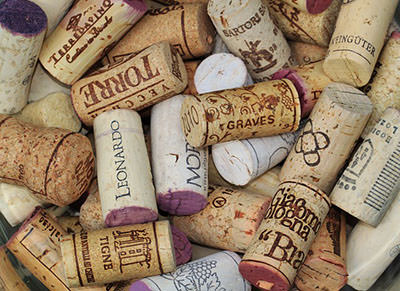Article from Alexander Eeckhout
 BODY
BODY
What is body?
It’s the sense of weight and richness a wine has, as well as the feeling of viscosity in your mouth. Wine from warmer climates generally have more body. Grapes in warmer climates produce more sugar which turns in to alcohol. The more alcohol a wine has, the more body it will have. But alcohol is not the only factor to create body in a wine. Sweetness and oak can add body to a wine as well.
Exercise
Equipment:
-4 glasses
-50 ml each of skim milk, 2% milk, whole milk and heavy cream
Taste the milk from light to rich. Examine the texture of each and the sensation in your mouth. The skim milk should disappear quickly while the cream should cover your tongue.
ACIDITY
What is acidity in wine?
Acidity in wine comes from natural occurring acids in the grapes and/or acids that are added in the production process. Acidity in grapes can vary greatly and depends on a number of factors such as sun exposure, climate and soil. Grapes grown in cooler areas are generally more acidic. You’ll feel the effects of acidity on the sides of your tongue.
Exercise
Equipment:
-five glasses of water of 110 ml
-1 orange
-1 grapefruit
-1 lemon
-1 lime
Set aside the first glass of water.
Squeeze 1/4 of the orange juice into the second glass. Squeeze 1/4 of the grapefruit juice into the third glass. Into the fourth, squeeze 1/2 of the lemon and squeeze 1/2 of the lime in the fifth glass.
Taste in the order described above. You’ll experience increasing acidity. Experiment by adding more juice to each glass to see how the acidity increases. Try to notice the point where it becomes too sour.
TANNINS
What are tannins?
Tannins are compounds in grape skins, seeds and stems. They contribute to a wine’s structure, complexity and texture. This is especially the case in red wine. You’ll find they create a drying and slightly bitter sensation in the mouth, usually toward the back of the tongue.
Tannic wines pair well with rich foods and substantial meat dishes. Fat softens the perception of tannin, making the wines more approachable.
Exercise
Equipment:
-3 mugs
-3 black tea bags
-hot water
Pour 250 millilitres of hot water in every mug. Place a tea bag in each mug and start a timer. Remove the bag from the first cup after two minutes, after four minutes remove the bag from the second one and after 8 minutes remove the bag from the third cup.
Taste the teas in order of steeping time, from shortest to longest. Swirl the tea in your mouth before swallowing, you’ll notice the bitterness increases with the steeping time.
SWEETNESS
What is sweetness in wine?
Sweetness in wine is measured by the amount of residual sugar left after fermentation. Sweetness in wine only comes from sugar content. Acidity can mask some of the sweetness in wines as in German or Alsatian Rieslings. It contributes to a wine’s body and texture.
Exercise
Equipment:
-500 ml glass with 250 ml of water
-2 lemons
-200 g of sugar
Squeeze the juice of the lemons into the water and stir.
Taste the mixture. You’ll notice it’s tart.
Stir one teaspoon of sugar and taste. Keep adding teaspoons and tasting after every teaspoon. Try to find the right balance of sweetness and sourness.
AROMAS AND FLAVOURS
What accounts for a Wine’s aromas and flavours?
A wine’s flavours come from the climate, amount of sun exposure, the soil and of course the grape variety. Different winemaking techniques will also amount to various flavours.
What’s the best way to describe a wine’s flavours and aromas?
Everyone tastes and smells different flavours and aromas in wine. It’s very subjective. Yet, the more tasting experience you have, the more easily you’ll be able to identify flavours. Having a personal list of flavours can be useful when ordering wine from a sommelier or talking with a salesperson at a wine shop. It’s most useful, of course, when pairing wines with food.
Exercise
Equipment:
-Blindfold
-Lychee
-Pencil shavings
-Mushrooms
-Bacon
-Rock
-Sage
-Raspberries
-Cassis
-Lime zest
-Orange blossom water
Put on the blindfold and have somebody set out the aromatic items in front of you in a random order.
Smell every item. Aroma accounts for the majority of your taste. This exercise will give you a better idea of what you like and will give you a list of flavours to have on hand when tasting.
OAK
What is an oaked wine?
The oak barrels that are used in winemaking are fire-charred. This gives them toasty, caramel and vanilla flavours. Depending on the winemaker’s preference, barrels are toasted to different levels. Old oak is sometimes favoured over new oak because it’s effect on a wine is more subtle.
Exercise
Equipment:
-Box of cheerios
-Marshmallow
-Skewer
Crush the cheerios and smell them. The wheaty and toasty notes are quite similar to those in oaken white wine.
Skewer the marshmallows and roast them over a flame until charred. You can use a gas stove for this. The burnt smell of a marshmallow is similar to the impression oak leaves in red wine.
Tasting wine is a matter of exercise and experience, so don’t worry about getting it right from the start. It’s a journey of the senses, discovering and appreciating the complex world that is wine. Enjoy!



 0
0